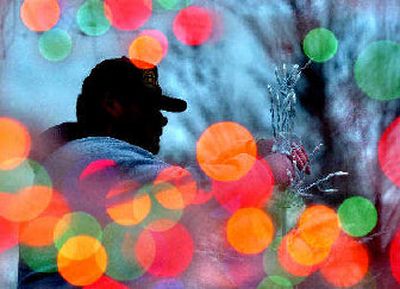Options aplenty in holiday lighting

Choosing decorative holiday lighting was much easier (though, perhaps, less safe) in colonial times, when candles were the only option. These days, there are enough choices to make your head spin – not a good idea if you’re standing on a ladder.
Need to know: With about 300 styles of Christmas lights on the market, it’s a good idea to decide at the outset just what you’ll be illuminating and then figure out how that translates into yards and yards of bulbs and wires. That way, you’ll buy just what you need (and maybe an extra string).
Safety first: Check for red or green Underwriters Laboratories (UL) marks on all light strings and extension cords. A green holographic UL mark means the light strings should be used only indoors. A red holographic UL mark indicates the light strings can be used both inside and out.
To color or not to color: Clear (white) lights are still the top sellers for trimming trees and wreaths and for decorating the house, both inside and out. Colored lights’ popularity rises and falls. But they’ve been on the upswing in recent years. That includes the traditional ceramic holiday lights (the large bulbs popular 25 to 30 years ago) as well as crystal and iridescent bulbs.
Shapes aplenty: There are icicle light sets, for porches and fascia; rope lights, to wrap around trees; and net lights, for shrubs. Also, 6-inch light spheres and light clusters that look like grapes; candle lights, beaded icicle lights, red carnation lights, holly-berry lights, and cell-phone lights. Some lights twinkle; others don’t.
What will it cost? Five dollars for a set of 300 clear indoor/outdoor miniature rope lights; about the same for 150 net or multicolored miniatures. Light spheres and light clusters run about $10 for 100.
Still more options: Lighted reindeer scattered throughout the yard have become almost as popular as icicle lights – they’re actually wires of lights shaped like the critters. Depending on size, they can run from $10 to $100.
No evergreens of your own to light? White metal, prelighted replicas cost $70 for a 7-foot tree, about $50 for a 5-footer.
Don’t forget to ask: Remember timers, since you don’t want to waste motion or energy turning the lights on and off. Make sure the timers are rated for outdoor use. Also, be sure the extension cords you buy are rated for the outdoors. If you don’t have a ground-fault circuit interrupter receptacle outdoors, buy an extension cord with a built-in GFCI for about $25.
Operating manual: Follow manufacturers’ guidelines for stringing light sets. As a general rule, UL recommends using no more than three standard-size sets of lights together. Do not overload extension cords or electrical receptacles.
Place the brightest lights closest to the house, the dimmer ones farther away. That keeps the dim lights from being lost in the greater glow. Wrap roping, garland or lights around banisters and columns in barber-pole fashion. Intertwine lights with nonlighted garland in the same manner. Secure bows onto garland with florist wire or long ties.
Lighting the way: If you illuminate your driveway especially for the holidays, make sure there’s enough room for vehicle turnaround and navigation. Some guests may be unfamiliar with the driveway, so allow at least one foot of clearance on either side, to keep lights from being crushed. And make sure animals won’t be able to entangle themselves in your decorations.
An ounce of prevention: Inspect last year’s holiday lights and extension cords before reusing them this year. Replace any that are fraying or otherwise damaged. Pay special attention to lights, cords or decorations that may have been damaged by winter weather.
Indoors, unplug all holiday lights when you go to sleep or leave home. Roll up excess electrical cords and keep them away from high-traffic areas. Do not run electrical cords under rugs. Never keep an extension cord plugged in when it’s not in use.